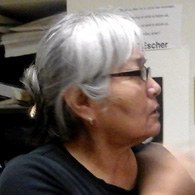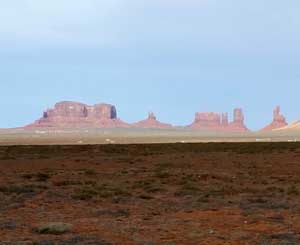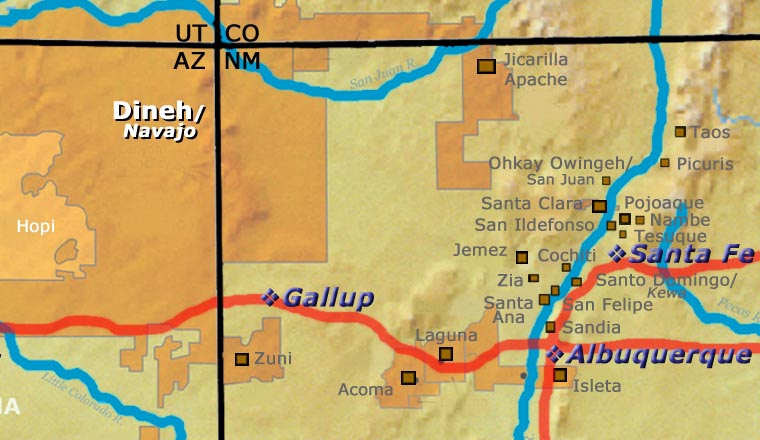
Christine McHorse
1948-2021
Dineh


Christine Nofchissey was born in December, 1948, and grew up mostly in the Clifton-Morenci area of Arizona. Her father was a heavy equipment operator in the open pit copper mines there. The family had been removed from the Navajo Nation and placed where they would most likely melt into the local population. However, Mark and Ethel Yazzie Nofchissey were not average Navajos, they simply preferred to take "roads less taken." While most Native Americans employed at the Phelps Dodge Morenci Copper Mine lived in a large tent city, their family bought a house and lived in nearby Clifton. At home they spoke English and they and their father's niece's children were the only Native American children in the Clifton schools. In addition, Mark was fascinated with Zen philosophy and the literature of the Rosicrucians. The children grew up in a home environment of creative ideas backed by creative mentoring. They were encouraged to exercise their minds and to invent without fear. However, because the Clifton-Morenci area was a major copper mining center, it was also a dangerous, ugly, violent and culturally barren place. Alcoholism was endemic.
Proud to be 100% Dineh, she spent most of her early summers herding sheep with her grandmother near Ganado on the Navajo Nation. When she was fourteen, her older sisters convinced her parents to send her to attend the Institute for American Indian Arts in Santa Fe. The Institute was still young then and many tribes wondered if it might not weaken their people's connection with their heritage, but the opposite proved to be true. Many of the students were hiding out there trying to escape the harsh realities of day-to-day Native American life.
Christine was allowed to attend and she graduated in 1966. She started with glassblowing but that was discontinued in her first year there. So then she tried ceramics, jewelry, foundry arts, design and painting. She finished as a jeweler, then she stayed for a couple years of post-graduate study. A year later she married Joel McHorse, a silversmith from Taos Pueblo (Joel's father, Mace McHorse, was an Irish-Texan cowboy, hence the name).
Christine told us she learned most of her pottery making techniques from Joel's grandmother, Lena Archuleta. Typical Taos pottery is simple and elegant with few decorative elements beyond the surface of micaceous clay. The tiny flecks of mica infuse the clay and act as temper when the clay is fired. When Christine did add a design element, her designs were drawn from the rich pantheon of Dineh tradition.
Christine grew up Dineh (off-reservation), then married a man from Taos Pueblo and lived most of her life among Anglos in Santa Fe. She felt that none of the three cultures had much influence over how she worked: she created whatever she felt the clay suggested that she create. The freedom of expression that came with that extended even to the process whereby she fired her pots.
Some pots she fired the Dineh way, in a pit outdoors. Then she coated them with hot pinon pitch. Others she fired indoors in a kiln. Still others she fired in a kiln, then refired outdoors to produce the interaction between fire and pinon pitch that she felt the fire clouds on a particular piece demanded. Always, she approached her art with the depth of Dineh spirituality and Earth-connection infused in her during those long summers growing up, spent on the Navajo Reservation with her grandmother.
Christine's resume lists pages of honors and awards she earned and exhibitions she participated in over the years, beginning with her first submission to the Santa Fe Indian Market in 1984. She earned at least one blue ribbon almost every year she went to the Santa Fe Market. In 1992 she went to Santa Fe with only 2 pots, entered them in 2 different categories, earned 2 blue ribbons, returned to her booth and a waiting line of would-be buyers. She was headed back home by mid-morning of the first day, sold out.
Christine didn't participate in Indian Market any more after that. She'd graduated to the world stage and her work was being shown in exhibitions and galleries from Santa Fe to New York to Canada and Germany.
While Christine may not have participated in Santa Fe's Indian Market in her later years, she did participate for several years in the Best of the Best Show at Andrea Fisher Fine Pottery. The Best of the Best Show has opened just before Indian Market officially began, for several years now.
Sadly, Christine passed away February 17, 2021.
Some Exhibits that Featured Works by Christine
- Catch 22: Paradox on Paper. Ralph T. Coe Foundation for the Arts. Santa Fe, New Mexico. August 12, 2017 - March 31, 2018. Note: group show curated by Nina Sanders and based on the Edward J. Guarino Collection
- Christine Nofchissey McHorse: Ceramics, Bronzes, Steel, and Drawings. Peters Project. Santa Fe, New Mexico. August 12, 2016 - November 5, 2016. Note: exhibit title also appears as "The Micaceous Ceramics of Christine Nofchissey McHorse"
- Home: Native Peoples in the Southwest. Heard Museum. Phoenix, Arizona. Opened May 22, 2005
- Anii Ánáádaalyaa̕ ígíí (Recent Ones That Are Made): Continuity & Innovation in Recent Navajo Art. Wheelwright Museum of the American Indian. Santa Fe, New Mexico. July 10, 1988 - October 30, 1988. Note: curators: Bruce D. Bernstein and Susan Brown McGreevy
100 West San Francisco Street, Santa Fe, New Mexico 87501
(505) 986-1234 - www.andreafisherpottery.com - All Rights Reserved

The Dineh

A view in Monument Valley
The Dineh refers to themselves as "Dineh" because the word means "the People" in their language. "Navajo" is a name that was given to them by the early Spanish. Historical and archaeological evidence points to the Dineh people entering the Southwest around 1400 CE. Their oral history still contains stories of that migration as the journey began in eastern Alaska and northwestern Canada centuries after their ancestors made the journey across the Bering Land Bridge from central Asia about 10,000 years ago. They were primarily hunter-gatherers until they came into contact with the Pueblo peoples and learned the basics of survival in this drier climate. Dineh oral history points to a long relationship between the Dineh and the Puebloans as they learned from and traded with each other.
When the Spanish first arrived, the Dineh occupied much of the area between the San Francisco Peaks (in Arizona), Hesperus Mountain and Blanca Peak (in Colorado) and Mount Taylor (in New Mexico). Spanish records indicate they traded bison meat, hides and stone to the Puebloans in exchange for maize and woven cotton goods. It was the Spanish who brought sheep to the New World and the Dineh took to sheep-herding quickly with sheep becoming a form of currency and sign of wealth.
When the Americans arrived in 1846, things began to change. The first fifteen years were marked by broken treaties and increasing raids and animosities on both sides. Finally, Brigadier General James H. Carleton ordered Colonel Kit Carson to round up the Dineh and transport them to Bosque Redondo in eastern New Mexico for internment. Carson succeeded only by engaging in a scorched earth campaign in which his troops swept through Dineh country killing anyone carrying a weapon and destroying any crops, livestock and dwellings they found. Facing starvation and death, the last band of Dineh surrendered at Canyon de Chelly.
Carson's campaign then led straight into "the Long Walk" to Bosque Redondo, a 300-mile trek during which at least 10% of the people died along the way. At Bosque Redondo they discovered the government had not allocated an adequate supply of water, livestock, provisions or firewood to support the 4,000-5,000 people interned there. The Army also did little to protect them from raids by other tribes or by Anglo citizens. The failure was such that the Federal government and the Dineh negotiated a treaty that allowed the people to return to a reservation that was only a shadow of their former territory little more than a couple years after they had left. However, succeeding years have seen additions to the reservation until today it is the largest Native American Reservation in the 48 contiguous states.
Large deposits of uranium were discovered on the Navajo Nation after World War II but the mining that followed ignored basic environmental protection for the workers, waterways and land. The Dineh have made claims of high rates of cancer and lung disease from the environmental contamination but the Federal government has yet to offer comprehensive compensation.
As a semi-nomadic tribe, the Dineh never made much pottery, preferring to use baskets for most storage purposes. They did produce a small amount of pottery for ceremonial uses. Once they were settled on a reservation, pottery began to make more sense. From a beginning making simple wares for colonial estates they transformed their pottery into art. After 1950 Cow Springs brownware began to appear on the market. A trader named Bill Beaver was in Shonto back then, encouraging local potters to "make something different" and the market in the outside world responded positively to those different creations.
Rose Williams is considered the matriarch of modern Dineh pottery. She learned from Grace Barlow (her aunt) and passed her knowledge and experience on to her daughters and many others. Today, most Dineh pottery is heavy, thick-walled and coated with pine pitch (a sealer they also use on many of their baskets). Most Dineh pottery has little in the way of decoration but many pieces have a biyo' (a traditional decorative fillet) around the rim. Unlike Puebloan potters, Dineh potters do not grind up old pot sherds and use them for temper in creating new pottery. Their religion says those pot sherds are infused with the spirits of their ancestors and that forbids the reuse of the material. Similarly, Dineh religion limits Dineh potters to using primarily Dineh carpet designs in the decoration of their pots.
Dineh potters have also created a panoply of folk art, including unfired clay creations called "mud toys." Other Dineh potters, like Christine McHorse, have graduated into the mainstream of American Ceramic Art and easily compete among the finest ceramic artists on Earth.
100 West San Francisco Street, Santa Fe, New Mexico 87501
(505) 986-1234 - www.andreafisherpottery.com - All Rights Reserved
